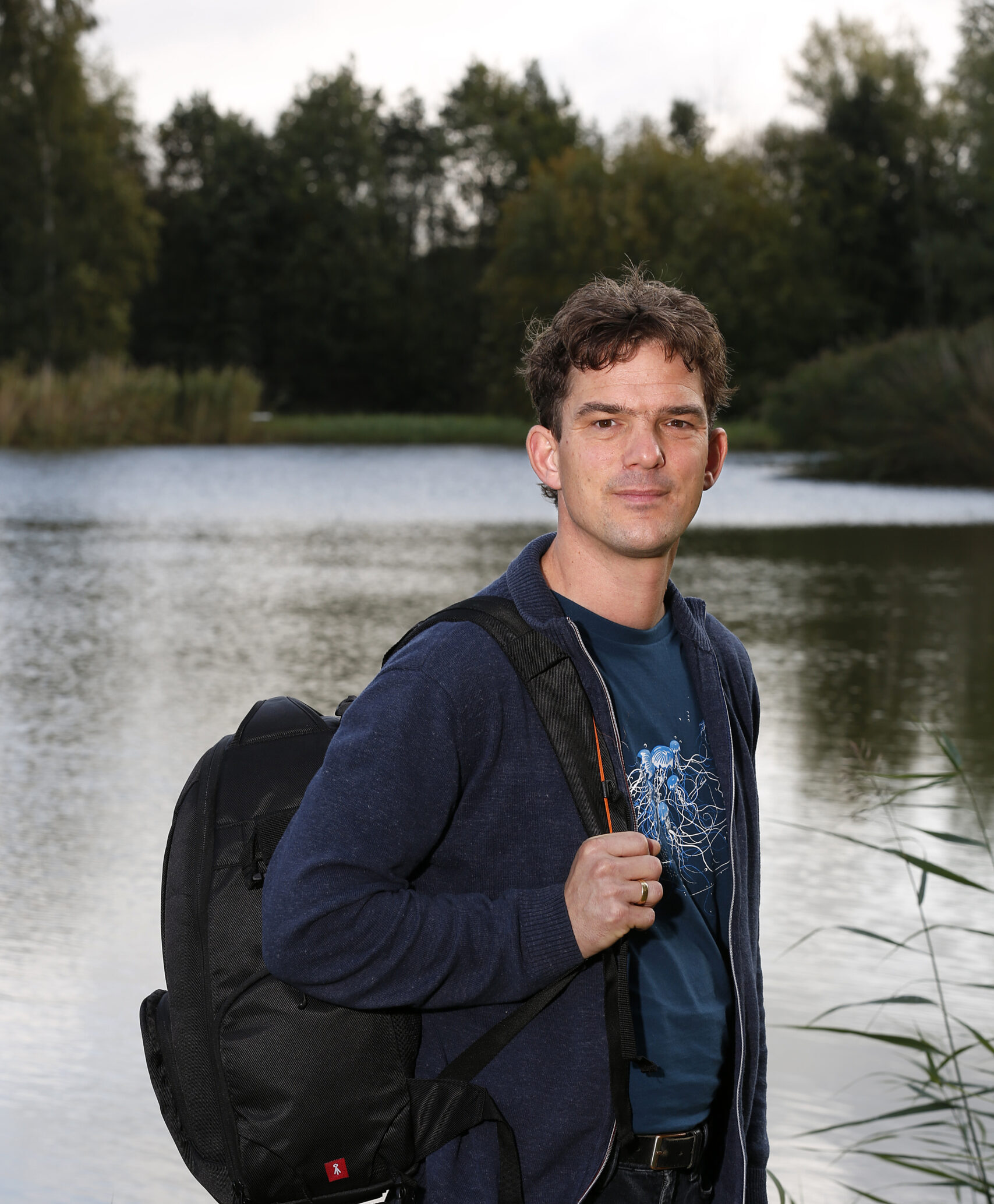Give him a litre of water and about four hours, and Reindert Nijland will tell you exactly which fish have been swimming in the water. It’s like CSI, but then for real. And he doesn’t even need any big machinery to do it.
Molecular biologist Reindert Nijland of the Marine Animal Ecology chair group takes a camera bag out of the cupboard. It contains his mobile DNA lab with everything he needs to carry out genetic analyses using environmental DNA, or e-DNA. He can use e-DNA to identify all the genetic material organisms leave behind in their environment, such as scales, mucus and excreta, for instance. Organic waste that continuously leaves a kind of fingerprint in the water.
DNA field guide
With the right techniques you can pick up, amplify and sequence the genetic trail and trace it back to its original owner. Science is making extremely rapid progress in sequencing the letters of the genetic code. The most astonishing piece of high tech involved is the MinION nanopore sequencer that Nijland works with (see inset). No bigger than a stapler, this gadget can read DNA codes at lightning speed. At a rate of 200,000 letters (bases) per second, to be precise. The MinION can process about 80,000 fragments of DNA, each with 2000 base pairs, in one and a half hours.
Monitoring in the North Sea can become faster and cheaper with e-DNA
But that data is only of any use if you can identify those codes, adds Nijland. And that is where the bottleneck was for a long time. ‘To identify species, you need a database with “barcodes”: bits of genetic code that are unique to a species. You could compare it to a field guide. You can’t do much without one.’
Detectable trail
There is now a database of this kind for the fish found in the North Sea, making it possible to use e-DNA to monitor where a particular fish has been. ‘But it doesn’t tell us much about the numbers of that species, and therefore about populations,’ Nijland emphasizes. The method is still new and its potential and limitations are being studied.
How long does a fish’s trail remain detectable, for example? ‘For e-DNA in salt water, it is more a question of hours than of days,’ says Nijland. ‘The longer a fish stays the more material it leaves behind, and the easier it is to demonstrate its presence. But you can even detect a fish that has just swum by. We are still working on the spatial factor. In fish hotels – concrete structures where fish can shelter – located in the Haringvliet estuary, we see that detection can be very local. For example, we can find no DNA of the round goby 50 metres from the hotel, whereas we know the fish are present in large numbers close to the hotel.’
Impact of fisheries
One of the applications of the MinION is the European GEANS project, which stands for Genetic tools for Ecosystem health Assessment in the North Sea. The project is studying the possibility of replacing the current way of monitoring seabed fauna in the North Sea with e-DNA analysis of soil samples from which the DNA is isolated and sequenced. WUR is closely involved in this project. Nijland: ‘The North Sea is being intensively monitored to reveal the impact of fisheries, wind turbines, sand extraction and the like. That is time-consuming and expensive. It might be possible to do it a lot faster and more cheaply with e-DNA analysis. Within this project we lead the work on harmonizing and standardizing the method.’ Nijland has no doubts about the success of the method. ‘The biggest challenge is to convince our colleagues in Europe that nanopore sequencing should become the standard method.’
Porpoises
According to Niland, the new method opens up still more possibilities. Such as identifying an individual animal, he dreams out loud. ‘That is impossible for fish. There are just too many of them. But the method we use to detect fish DNA can detect mammal DNA too. We are currently developing an individual identification system for porpoises. That can give you a fingerprint of an individual animal you have never seen.’
Identifying fish e-DNA with MinION
Researcher Reindert Nijland identifies the environmental DNA (e-DNA) of North Sea fish with a smart little gadget: the MinION nanopore sequencer. The process starts with taking a water sample. Being a diver, Nijland enjoys doing that himself, using bright blue balloons. ‘From Action discount store, cheap and cheerful but strong enough.’
Next, Nijland filters the DNA out of the water and isolates it. He then proceeds to amplify the DNA signal he is interested in, namely that of fish. He does that by copying a fragment of mitochondrial DNA specific to fish several billion times using polymerase chain reaction. The resulting fish DNA, with long barcodes of 2000 base pairs (letters), is then ready to be sequenced by the MinION.
It is a crafty method. ‘Single-strand DNA fragments pass across a plate in the gadget with little electrified channels – nanopores,’ explains Nijland. ‘The bases, the letters of the DNA code, create resistance in the channel, each letter in its own way. The difference in resistance turns into a changing electric signal, which is linked to the letters of the genetic code.’ The gadget works at lightning speed, with each of the 500 pores reading 400 letters per second.

 Reindert Nijland. Foto: Aldo Allessie
Reindert Nijland. Foto: Aldo Allessie